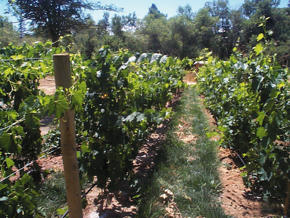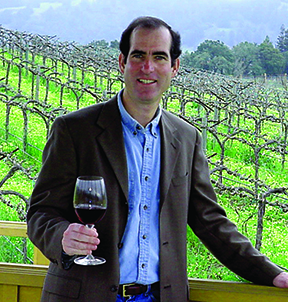
“Mark? Don’t you want to take a look inside the house?” Hmmm. Check out that land. “Mark? The house?” Yeah … sure. The house. I take one last, inclusive look at the “backyard” of the home in Chicago Park, California. I see one-and-a-half acres of fertile land that faces south and slopes gently away from me. Look at the house? I don’t need to look at the house. After driving 770 miles from our current home in Seattle, and spending a long week looking at potential homesteads that just weren’t right, I had finally found what I was looking for. Did I mention that Chicago Park is in the Sierra foothills, just a little east of Sacramento? At a perfect elevation of 2,300 feet? With average mean temperatures and precipitation averages similar to certain high-rent districts of Napa Valley? Did I mention the Internet article telling of how a well-respected Italian vineyard owner had almost transplanted to this area? And I couldn’t have forgotten to mention how much I love Italian wines!
We bought the house in April 2000, and I immediately set about clearing off the old pasture fencing while my wife Kimberly unloaded the moving van. In the winter of 2000 I began preparing the soil. I read a slew of books and spent evenings surfing the Web for up-to-date, location-specific information. It seemed pretty straightforward: break up the ground, set the trellis, plant some fruit, play around with the vines for a few years, make some wine.
 The first inkling that I had no clue what I was doing occurred when the spade hit the ground. After 18 inches of beautiful topsoil I found eight inches of hardpan clay, the really greasy “baby poop” stuff. It didn’t take a DSL connection to the information super-highway for me to know this was bad. I dug through the clay and hit decomposed granite. OK! All the books said decomposed granite is good! Unless, of course, the stuff is so tightly compacted that water won’t percolate through it. Then it’s bad. A quick test indicated my granite had all the perkiness of concrete.
The first inkling that I had no clue what I was doing occurred when the spade hit the ground. After 18 inches of beautiful topsoil I found eight inches of hardpan clay, the really greasy “baby poop” stuff. It didn’t take a DSL connection to the information super-highway for me to know this was bad. I dug through the clay and hit decomposed granite. OK! All the books said decomposed granite is good! Unless, of course, the stuff is so tightly compacted that water won’t percolate through it. Then it’s bad. A quick test indicated my granite had all the perkiness of concrete.
I recalled reading in one of my books about a vineyardist who would not sell the author any vines until he had dug holes three feet wide by three feet deep, filled the holes with good soil and let them sit for a year. I couldn’t bring myself to dig 150 three-by-three holes. After all, that’s why man invented tractors and augers. Instead, I settled for holes that measured one foot wide by two feet deep. It took two cubic yards of garden dirt and a weekend of prison-labor type work to fill the holes. How could my grapevines not be happy with that?
Our area has not been infected by phylloxera, but I didn’t want to take any chances. I ordered 150 Sangiovese Clone 4 vines, bench-grafted onto a phylloxera-resistant native rootstock with the fetching name of 101-14. I chose 101-14 because it is said to tolerate “wet feet,” and given the layer of concrete in my vineyard, I figured I should hedge against potential problems caused by standing water. Also, 101-14 is considered to be minimally vigorous rootstock. Sangiovese is world-renowned for being overly vigorous, so I planned to tame it with the 101-14 whip. In selecting the vine to plant, I mostly went with what I like to drink; Sangiovese is the primary grape used in Chianti and Brunello de Montelcino wines. There is skepticism by some Italian industry types about the viability of Sangiovese vines in California, but then again, there is still skepticism by some French industry types about Cabernet and Chardonnay in California! While picking up the grafted vines at NovaVine in Santa Rosa, I also purchased trellising wire, wood posts and “grow tubes.” Grow tubes are plastic shells that protect fledgling grapevines from the elements and act as a mini-greenhouse. You often will see milk cartons serving the same purpose, but I didn’t want to see a bunch of milk cartons scattered around my backyard.
In all, my backyard hobby cost about $1,200 up front. It’s a good thing some vineyard-development companies charge upwards of $30,000 an acre. That was my ace-in-the-hole argument when Kimberly saw the credit card bill.
I used pressure-treated wood posts for my trellis because it made the vineyard look “authentic.” But I wouldn’t do that again. Wood posts cost three times more than metal posts, they are harder to drive into the ground, and I later learned that if you use pressure-treated wood in your vineyard some governing entities are unwilling to certify it as “organic.” I’m not hung up on the organic thing, but now I may not be able to get certified, even if I want to.
Trellis selection issues are to viticulturists what the “nature of God” discussion is to theologians. There are many trellis systems, and the debate over which is best in a particular circumstance involves a great deal of passion and endless arguments. My trellis system is called VSP, which stands for “vertical shoot positioning.” It’s the most common form in California, mostly because it works, it’s easy to set up, and maintenance is fairly low.
We had a late frost that season. Of course we had a late frost; I’d just planted a vineyard. So I spent the night standing in my vineyard with a thermometer in one hand and the water hose in the other. My toes survived the frost and I only lost two plants. I somehow avoided the bugs that hit my neighbor’s Zinfandel vines — but I didn’t escape the attention of Bambi and his pals. The grow tubes protect the vines for a while, but eventually they grow above them, and when they do, they send out a siren song that only North American white-tailed deer can hear. My dog hasn’t grasped the concept of homestead varmint protection, so 500 feet of deer fencing and $700 later, my vineyard was Bambi-free.
By July 2001, people were commenting about my fine-looking vineyard. Did I mention that Sangiovese is known for being vigorous? My primary reference book, “From Vines to Wines” by Jeff Cox (Storey Books, 1999), says that if the young vines reach the second trellis wire by the end of the first season, things are going well. These guys reached the second wire … two rows over. Digging those holes must have done the trick, because my vines were hap-hap-happy and crazy with life. Ironically, this could turn out to be the most challenging part of successful vineyard development. The ultimate goal is to produce grapes that make a high-quality wine, and excessive vegetation and quality grapes have an inverse relationship. If I’m going to make good wine, I’ll have to control the growth of the vines. This is the area in which I found the widest divergence of opinion among vineyard experts. For every expert who suggested reining in the vines through “close-spacing,” I found an expert recommending the exact opposite. Fertilize, don’t fertilize. Water, don’t water. Plant north-south, plant east-west … you get the picture. I chose to space closely, fertilize and water regularly during the first year, use VSP trellising and plant north-south. As my vines develop and I start limiting both fertilizer and water, the combination of close-spacing and the use of 101-14 rootstock will hopefully limit the need for using a machete to walk down the rows.
Using advice from an article in a viticulture magazine, I pruned one of the rows in a fashion that should allow for harvesting next year. This is another big no-no in viticulture. You are never, never, ever supposed to attempt a harvest until year three or four. But what the heck: Conventional wisdom says I’m not supposed to plant my rows five feet apart, either. After all this work, I want some grapes!
The vines finally stopped growing in October. The trunk and vines turned woody in early November and a Thanksgiving frost caused all the leaves to drop. After I raked up the leaves, there wasn’t much to do except wait until February, when I plan to prune. I don’t believe I’ve ever felt what I am feeling today — an unbearable impatience for spring to arrive. It has been a great deal of work, and the learning curve is far steeper than I thought it would be. But as I look out over the 150 vines in my backyard, I can’t help but think that this is one of the coolest things I’ve ever done.







